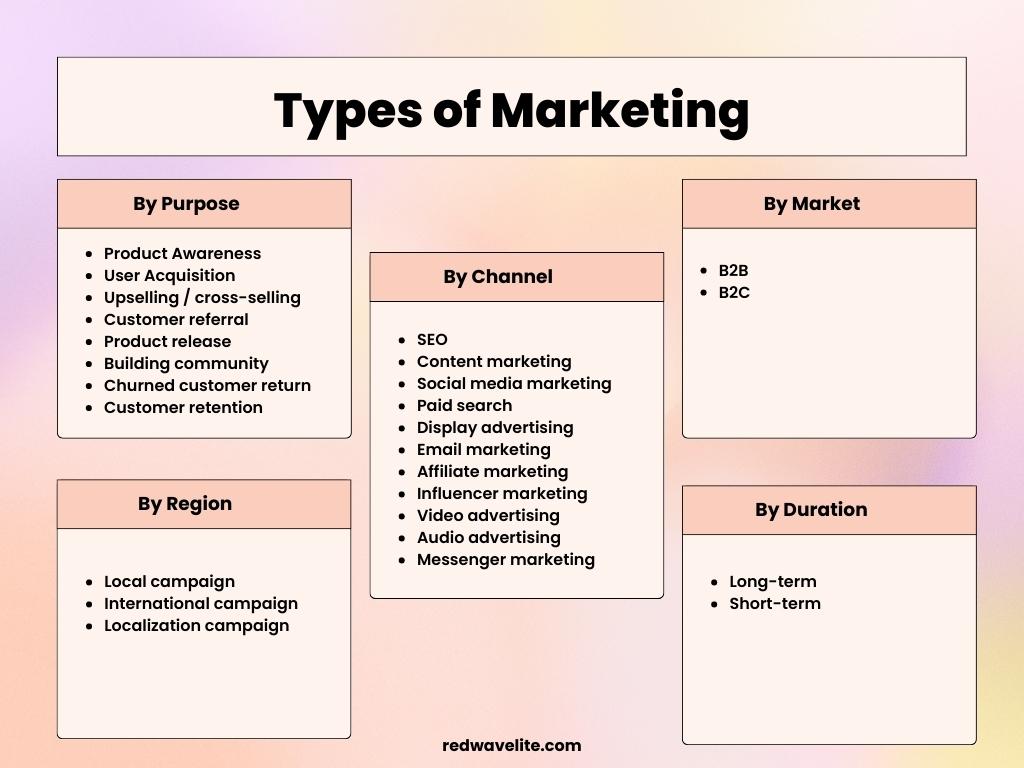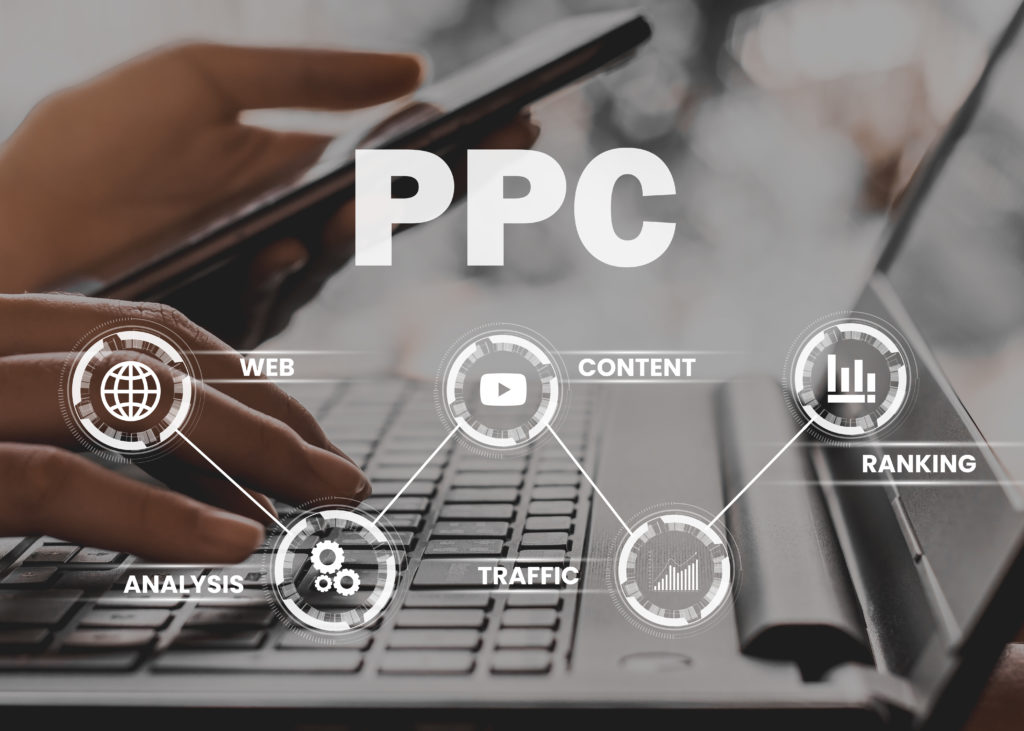Marketing is a dynamic field that has a wide range of strategies and approaches to connect with target audiences and achieve business goals. In this article, we delve into the various types of marketing strategies, shedding light on their unique characteristics, benefits, and suitable applications. By understanding the diverse marketing landscape, businesses can make informed decisions and develop effective campaigns for their specific objectives.

Marketing By Channel
- SEO (Search Engine Optimization):
SEO focuses on optimizing a website’s content and structure to improve its visibility in search engine results pages (SERPs).
Example: Optimizing website content with relevant keywords, improving site speed, building high-quality backlinks, and creating a user-friendly website experience to increase organic search traffic.
- Content Marketing:
Content marketing involves creating and distributing valuable, relevant, and consistent content to attract and engage a target audience.
Example: Publishing blog posts, articles, infographics, or videos that educate, entertain, or inspire the audience, thereby establishing the brand as an industry thought leader and building trust.
- Paid Search (PPC – Pay-Per-Click) Advertising:
Paid search refers to advertising on search engines, where advertisers pay a fee each time their ad is clicked by a user.
Example: Running Google Ads campaigns, bidding on specific keywords, and displaying ads above or alongside search results to drive targeted traffic to a website.
- Social Media Marketing:
Social media marketing involves utilizing social media platforms to promote products or services, engage with customers, and build brand awareness.
Example: Creating engaging and shareable content, running targeted ad campaigns, and interacting with followers on platforms such as Facebook, Instagram, Twitter, or LinkedIn.
- Email Marketing:
Email marketing involves sending targeted emails to a list of subscribers to increase leads, promote products, share updates, or build customer loyalty.
Example: Sending personalized newsletters, automated welcome emails, abandoned cart reminders, or exclusive offers to engage and convert subscribers into customers.
- Affiliate Marketing:
Affiliate marketing is a performance-based marketing strategy where affiliates earn a commission for driving traffic or generating sales for a brand through their own promotional efforts.
Example: Collaborating with influencers, bloggers, or content creators who promote a brand’s products or services through unique tracking links, earning a commission for each successful referral.
- Influencer Marketing:
Influencer marketing involves collaborating with influential individuals on social media platforms to promote products or services and reach their followers.
Example: Partnering with popular Instagram influencers to showcase and endorse a brand’s products through sponsored posts, stories, or product reviews.
- Video and Audio Marketing:
Video and audio marketing involve creating compelling visual or auditory content to engage and communicate with the target audience.
Example: Creating product explainer videos, brand storytelling videos, video tutorials, or hosting a podcast series to convey messages, demonstrate products, or share industry insights.
- Messenger Marketing:
Messenger marketing utilizes messaging apps and chatbots to interact with customers, deliver personalized messages, and provide customer support.
Example: Implementing Facebook Messenger bots to engage with customers, send automated responses, provide product recommendations, or facilitate transactions.






Marketing By Purpose
- Product Awareness:
Product awareness marketing aims to generate visibility and familiarity for a new or existing product among the target audience.
Example: Running social media campaigns, content marketing efforts, influencer collaborations, or traditional advertising to introduce the product, highlight its features, and create buzz.
- User Acquisition:
User acquisition marketing focuses on attracting and acquiring new customers or users for a product or service.
Example: Implementing paid advertising campaigns, search engine optimization (SEO) strategies, content marketing, referral programs, or lead generation campaigns to drive qualified traffic and convert visitors into customers.
- Up-selling and Cross-selling:
Up-selling and cross-selling marketing aims to increase the average purchase value by encouraging customers to buy additional or upgraded products or related products.
Example: Recommending higher-tier product bundles or premium features during the checkout process, offering complementary products on product pages, or sending personalized email recommendations based on past purchases.
- Customer Referral:
Customer referral marketing incentivizes existing customers to refer new customers to the business, leveraging word-of-mouth and social influence.
Example: Implementing a referral program where customers receive rewards or discounts for referring friends or family members, sharing referral codes or links on social media, or sending personalized referral emails.
- Product Release:
Product release marketing focuses on generating excitement and interest around a new product launch or significant product update.
Example: Teasing the product through social media sneak peeks or teaser campaigns, hosting launch events or webinars, collaborating with influencers for product reviews, or sending exclusive pre-launch emails to build anticipation.
- Building Community:
Community-building marketing aims to create a sense of belonging and engagement among customers or users by creating platforms for interaction and shared experiences.
Example: Creating branded online forums or communities, hosting live Q&A sessions or webinars, organizing user meetups or events, or initiating social media discussions and user-generated content campaigns.
- Customer Retention:
Customer retention marketing focuses on nurturing and maintaining relationships with existing customers, enhancing loyalty, and encouraging repeat purchases.
Example: Implementing personalized email marketing campaigns, offering exclusive discounts or loyalty rewards, providing proactive customer support, sending relevant product updates or recommendations, or launching customer appreciation initiatives.


Marketing By Market
- B2B Marketing:
B2B marketing refers to marketing strategies and tactics directed towards businesses or organizations as potential customers or clients. It focuses on building professional relationships, demonstrating value, and addressing specific business needs.
Examples: Content marketing through industry-specific blogs, whitepapers, and case studies, attending trade shows and conferences, conducting targeted email campaigns, and establishing partnerships with other businesses.
- B2C Marketing:
B2C marketing focuses on marketing efforts directed toward individual consumers or end-users of a product or service. It emphasizes emotional appeal, convenience, and meeting consumer desires and aspirations.
Examples: Social media marketing to engage and influence consumers, creating eye-catching advertisements for television or online platforms, conducting influencer collaborations, running promotions, and implementing loyalty programs.
While both B2B and B2C marketing share similarities in terms of basic marketing principles, their strategies, and tactics often differ due to the distinct characteristics of their target markets. B2B marketing focuses on building trust and credibility among businesses, while B2C marketing typically aims to create emotional connections and drive immediate consumer actions.


By Duration
- Long-Term Marketing:
Long-term marketing strategies are designed for continuous brand building, customer acquisition, and relationship management. It focuses on establishing a strong brand presence, creating customer loyalty, and sustaining long-term growth.
Examples: Content marketing to consistently provide value and engage the audience, brand storytelling to create a compelling brand narrative, customer relationship management (CRM) to create relationships over time, and ongoing social media engagement to build a community.
- Short-Term Marketing:
Short-term marketing campaigns are time-bound initiatives with a defined start and end date, often used for specific promotions, events, or seasonal campaigns. It focuses on generating immediate results, such as increasing sales, driving website traffic, or creating buzz around a limited-time offer.
Examples: Limited-time discounts or promotions to drive immediate sales, seasonal marketing campaigns tied to specific holidays or events, flash sales, product launches, or time-limited contests or giveaways.
Balancing long-term and short-term marketing strategies is essential for sustained success. While long-term marketing builds a strong foundation and fosters brand loyalty, short-term campaigns provide immediate boosts and capitalize on specific opportunities or events.
By Region
- Local Marketing:
Local marketing strategies are geographically targeted marketing efforts focused on a specific region, city, or community. They are aimed at reaching and engaging customers within a local area and building a strong presence within the community.
Examples: Localized advertising in local newspapers or radio stations, sponsoring local events, participating in community outreach programs, partnering with local businesses, and optimizing online presence for local search.
- International Marketing:
International marketing strategies are implemented to target multiple countries or a global audience. They are made for specific international markets, taking into account cultural, linguistic, and regional differences.
Examples: Conducting market research to understand local preferences and behaviors, adapting marketing messages and campaigns to suit the cultural context, utilizing localized websites or landing pages, and partnering with local influencers or businesses for market entry.
- Localization Campaigns:
Localization campaigns involve adapting marketing materials, messages, and strategies to resonate with a specific local market or language. It focuses on linguistic and cultural customization to ensure relevance and effectiveness in a particular region.
Examples: Translating marketing content into local languages, adapting visuals and imagery to align with local customs and preferences, adjusting pricing and promotions to fit local market dynamics, and targeting local influencers or ambassadors.
By understanding and utilizing the various types of marketing strategies, businesses can create comprehensive and effective marketing campaigns that align with their goals, resonate with their target audience, and drive success in an ever-evolving and competitive market landscape.